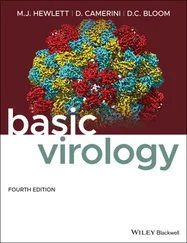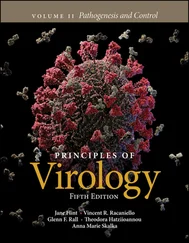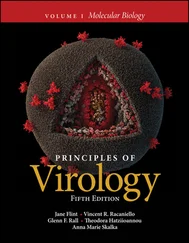Jane Flint - Principles of Virology
Здесь есть возможность читать онлайн «Jane Flint - Principles of Virology» — ознакомительный отрывок электронной книги совершенно бесплатно, а после прочтения отрывка купить полную версию. В некоторых случаях можно слушать аудио, скачать через торрент в формате fb2 и присутствует краткое содержание. Жанр: unrecognised, на английском языке. Описание произведения, (предисловие) а так же отзывы посетителей доступны на портале библиотеки ЛибКат.
- Название:Principles of Virology
- Автор:
- Жанр:
- Год:неизвестен
- ISBN:нет данных
- Рейтинг книги:3 / 5. Голосов: 1
-
Избранное:Добавить в избранное
- Отзывы:
-
Ваша оценка:
- 60
- 1
- 2
- 3
- 4
- 5
Principles of Virology: краткое содержание, описание и аннотация
Предлагаем к чтению аннотацию, описание, краткое содержание или предисловие (зависит от того, что написал сам автор книги «Principles of Virology»). Если вы не нашли необходимую информацию о книге — напишите в комментариях, мы постараемся отыскать её.
Volume I: Molecular Biology
Volume II: Pathogenesis and Control
Principles of Virology, Fifth Edition
Principles of Virology — читать онлайн ознакомительный отрывок
Ниже представлен текст книги, разбитый по страницам. Система сохранения места последней прочитанной страницы, позволяет с удобством читать онлайн бесплатно книгу «Principles of Virology», без необходимости каждый раз заново искать на чём Вы остановились. Поставьте закладку, и сможете в любой момент перейти на страницу, на которой закончили чтение.
Интервал:
Закладка:
3 Volume II Preface Acknowledgments About the Authors Key of Repetitive Elements 1 Infections of Populations: History and Epidemiology Introduction to Viral Pathogenesis A Brief History of Viral Pathogenesis Viral Epidemics in History Epidemiology Parameters That Govern the Ability of a Virus to Infect a Population Perspectives References 2 Barriers to Infection Introduction An Overview of Infection and Immunity Successful Infections Must Modulate or Bypass Host Defenses Viral Tropism Spread throughout the Host Organ Invasion Shedding of Virus Particles Perspectives References 3 The Early Host Response: Cell Autonomous and Innate Immunity Introduction The First Critical Moments: How Do Individual Cells Detect a Virus Infection? Cell-Intrinsic Defenses Secreted Mediators of the Innate Immune Response The Innate Immune Response Perspectives References 4 Adaptive Immunity and Establishment of Memory Introduction Attributes of the Host Response Lymphocyte Development, Diversity, and Activation Events at the Site of Infection Set the Stage for the Adaptive Response Antigen Processing and Presentation The CTL (Cell-Mediated) Response The Humoral (Antibody) Response Immunological Memory Perspectives References 5 Patterns and Pathogenesis Introduction Animal Models of Human Diseases Patterns of Infection Viral Virulence Pathogenesis Perspectives References 6 Cellular Transformation and Oncogenesis Introduction Oncogenic Viruses Activation of Cellular Signal Transduction Pathways by Viral Transforming Proteins Disruption of Cell Cycle Control Pathways by Viral Transforming Proteins Transformed Cells Increase in Size and Survive Tumorigenesis Requires Additional Changes in the Properties of Transformed Cells Other Mechanisms of Transformation and Oncogenesis by Human Tumor Viruses Perspectives References 7 Vaccines Introduction The Origins of Vaccination Vaccine Basics The Science and Art of Making Vaccines Vaccine Technology: Delivery and Improving Antigenicity The Ongoing Quest for an AIDS Vaccine Perspectives References 8 Antiviral Drugs Introduction Discovering Antiviral Compounds Drug Resistance Examples of Antiviral Drugs Expanding Targets for Antiviral Drug Development Two Stories of Antiviral Success Perspectives References 9 Therapeutic Viruses Introduction Phage Therapy Oncolytic Animal Viruses Gene Therapy Vaccine Vectors Perspectives References 10 Virus Evolution Virus Evolution How Do Virus Populations Evolve? The Origin of Viruses Host-Virus Relationships Drive Evolution Lessons from Paleovirology Perspectives References 11 Emergence The Spectrum of Host-Virus Interactions Encountering New Hosts: Humans Constantly Provide New Venues for Infection Common Sources for Animal-to-Human Transmission Viral Diseases That Illustrate the Drivers of Emergence The Contribution to Emergence of Mutation, Recombination, or Reassortment New Technologies Uncover Previously Unrecognized Viruses Perceptions and Possibilities Perspectives References 12 Human Immunodeficiency Virus Type I Pathogenesis Introduction HIV-1 Is a Lentivirus Entry and Transmission The Course of Infection Virus Reproduction Immune Responses to HIV-1 HIV-1 and Cancer Prospects for Treatment and Prevention Perspectives References 13 Unusual Infectious Agents Introduction Viroids Satellite Viruses and RNAs Prions and Transmissible Spongiform Encephalopathies Perspectives References APPENDIX: Epidemiology and Pathogenesis of Selected Human Viruses Adenoviruses Arenaviruses Bunyaviruses Caliciviruses Coronaviruses Filoviruses Flaviviruses Flaviviruses Flaviviruses Hepadnaviruses Herpesviruses Herpesviruses Herpesviruses Orthomyxoviruses Papillomaviruses Paramyxoviruses Paramyxoviruses Picornaviruses Picornaviruses Picornaviruses Polyomaviruses Poxviruses Reoviruses Reoviruses Retroviruses Retroviruses Rhabdoviruses Togaviruses Togaviruses Glossary Index
4 End User License Agreement
List of Tables
1 Chapter 2 Table 2.1 Particle-to-PFU ratios of some animal viruses
2 Chapter 3 Table 3.1 Some viral vectors
3 Chapter 4 Table 4.1 Functions of virion proteins Table 4.2 Nomenclature used in description of virus structure Table 4.3 Some virion enzymes
4 Chapter 7 Table 7.1 Strategies of transcription of viral DNA templates Table 7.2 Eukaryotic RNA polymerases synthesize different classes of cellular an... Table 7.3 Properties and functions of some viral transcriptional regulatorsTable 7.4 Viral RNA polymerase III transcription units
5 Chapter 9Table 9.1 Viral origin recognition proteinsTable 9.2 Replication systems of large DNA virusesTable 9.3 Viral enzymes of nucleic acid metabolism
6 Chapter 10Table 10.1 Comparison of retroviral integration site preferences in human cellsTable 10.2 Comparison of retroviral and hepadnaviral reverse transcription
7 Chapter 12Table 12.1 Some viral envelope glycoprotein precursors processed by secretory pa...
8 Chapter 13Table 13.1 Common sequence motifs required for budding of enveloped virus partic...
9 Chapter 17Table 3.1 Some viral modulators of the interferon responseTable 3.2 Some chemokine receptors and their ligands
10 Chapter 19Table 5.1 Incubation periods of some common virusesTable 5.2 Some persistent viral infections of humansTable 5.3 Epstein-Barr latency programs
Читать дальшеИнтервал:
Закладка:
Похожие книги на «Principles of Virology»
Представляем Вашему вниманию похожие книги на «Principles of Virology» списком для выбора. Мы отобрали схожую по названию и смыслу литературу в надежде предоставить читателям больше вариантов отыскать новые, интересные, ещё непрочитанные произведения.
Обсуждение, отзывы о книге «Principles of Virology» и просто собственные мнения читателей. Оставьте ваши комментарии, напишите, что Вы думаете о произведении, его смысле или главных героях. Укажите что конкретно понравилось, а что нет, и почему Вы так считаете.











